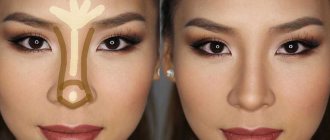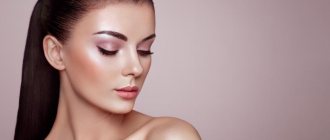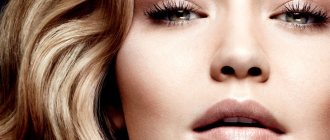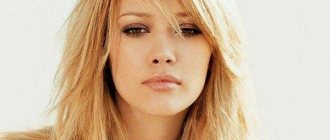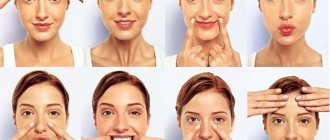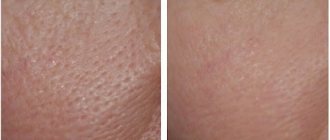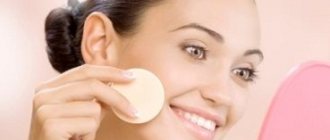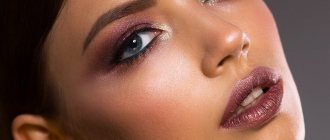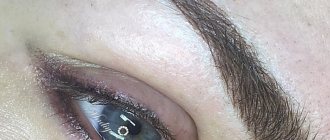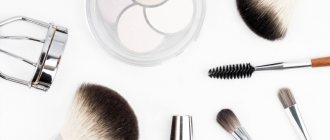Why do you need a face sculptor?
Filmmakers began to use facial sculptors. In the light of the spotlights, the actors' faces seemed flat; to add expressiveness, the Westmore brothers applied thin layers of makeup. Working with dark and light shades, they achieved relief and graphics. The faces of the actresses on the screen came to life.
The technique of cut-off correction has been adopted by makeup artists, actors, and announcers, and is now used at home. It’s interesting that we still use the diagrams drawn by the Westmore brothers for different types of faces.
Black and white correction solves a complex of problems.
- makes the look more graphic and younger;
- brings the oval of the face as close to ideal as possible;
- hides minor imperfections.
Cosmetologist's advice
For black and white correction, all well-known cosmetic brands produce products from foundations, sculpting powders and blushes, to light highlighters and shimmers, as well as modeling palettes. No matter what products you use, the main thing to remember is that your skin must be spotlessly clean.
Advice: since several layers of cosmetics are applied, you will also have to wash it off in several steps. After washing, do a control procedure - wipe the skin with lotion.
Artist Tips
If possible, acquire basic knowledge of the basics of painting and color science. Dark tones create shadows and pull the image deeper into the background. Light shades, on the contrary, create glare, enlarge, and make the object larger.
Carefully choose an undertone that matches your skin color. For women of European appearance, cool shades of sculptor, with a pink or grayish undertone, are more suitable.
Do not use shiny products; choose black-and-white correctors that have a matte texture.
Makeup artist tips
Before starting work, moisturize the skin with a suitable cream and apply the first base layer of a product that is as close as possible to the skin color. Evaluate what you see, think about which places need to be moved into the shadows and which ones need to be brightened as much as possible.
How to use a face sculptor correctly? The dark tone is applied below the line running from the top of the ear to the corner of the lips. We work the cheekbone with a brush from above, from the ear, down. Be sure to blend the edges thoroughly, otherwise you will get a bruised effect on your cheeks. If you do everything correctly, your cheekbones will visually “fall in” and your face will become narrower.
At the next stage, blush is applied above the sculptor's application line. And a brightening layer of highlighter is applied to the highest point of the cheek.
The sculptor’s dark shade is used to work on the areas above the temples, the upper part of the forehead near the hair growth area, and the area of the double chin. Matte brown shadows are suitable for experiments.
At the final stage, apply a thin translucent layer of powder. We work with soft clapping movements.
Features of sculptural makeup
Sculptural makeup is the correction and contouring of the face shape using foundation and powder cosmetics in order to remove imperfections and focus on the pluses of appearance. Often women, resorting to sculptural makeup, change dramatically. Many imperfections, both large and small, can be hidden by contouring.
The process involves highlighting some areas of the face and darkening others. When creating it, it is necessary to take into account a number of nuances.
Face shape designation
Face shapes are classified into the following 6 main types:
- Rounded - the forehead is wider than the chin, the cheekbones protrude, and the face itself gently narrows and visually resembles an oval.
- Narrow - long face
, forehead, cheekbones and jawline are almost the same in length. - Round – the face is wide, the forehead is often equal to the length of the face, and a fairly wide part of the face is located in the cheek area.
- Triangular - the forehead is wider than the chin, the cheekbones and forehead are almost similar in width, the face tapers to the tip of a sharp chin.
- The face is a square type - the forehead, cheekbones and jawline are almost similar in width, and the lower jaw is square.
- Face "Pear"; or an inverted triangle - the forehead is quite narrow, the face visually widens towards the chin, the jaw seems massive.
The ideal shape is considered an oval. Essentially speaking, you should strive for it when drawing contours.
Selection of cosmetics
For sculptural makeup, you can use dry powder cosmetic products, or use creamy foundations.
Choosing a face type and correction methods
Nature has endowed us with faces of excellent shape. Some are the happy owner of an oval, while others have it round, square or even triangular. The situation is corrected by hairstyles and knowledge of how to properly apply face sculpting. Determine your type and boldly begin experiments to improve your appearance.
Inverted triangle or heart face
A girl with this type is easy to recognize. Her face is wide at the top at the temples, and her chin is narrow, often sloping.
The purpose of modeling: to balance the upper and lower parts.
What we do:
- We visually expand the chin and apply the sculptor’s light tone to it.
- To attract attention, highlight the middle part - forehead, areas under the eyes, cheekbones.
- We apply a dark shade to the cheeks and temple areas, the face will appear narrow at the top.
Round form
Goal: to make it visually narrower.
Stages of work:
- We highlight the area in the middle of the forehead, above the cheekbones under the eyes, and the chin.
- We darken the side parts of the face that stand out from the ideal oval - temples, cheeks, jaw line.
Diamond shape
The owners of such faces have the widest part in the cheekbone area. Along the imaginary line of the temples and in the area of the lower jaw, the face is much narrower.
The purpose of the work: to soften overly pronounced cheekbones, to give the oval a more rounded outline.
Modeling:
- To widen the forehead and chin, we treat them with a light shade.
- We also apply highlighter above the cheekbones and under the eyes. This will draw attention to the middle part.
- The dark tone is applied to the cheekbones to achieve the maximum effect of the narrowness of this part of the face.
Square shape
Equally wide in all projections: along the cheekbones, forehead, lower jaw. It looks a bit heavy.
Goal: to give the entire face smooth outlines, soften the heavy angles of the lower jaw, and lighten the shape.
Our actions:
- Apply a light highlighter to the center of the chin, the area under the eyes above the cheekbones and on the forehead.
- Dark tone - at the temple along the hairline and protruding corners of the lower jaw.
Face sculpting products
Which cosmetic products you should purchase for this process depends on what type of adjustment you will be doing. Let's look at the most necessary means and tools for sculpting.
Face sculpting palette
In the process of correcting the face, cream highlighters and correctors, as well as dry bronzers, are used.
If the makeup is done by a professional, then translucent powder is used to set it. To darken certain areas of the face, you need a bronzer and a dark-colored corrector, and to highlight, you need cream, liquid or dry highlighters.
Professional makeup artists advise contouring in daylight. The correction technique is not complicated, the main thing is the correctly selected shades of products in a special palette and their careful shading. The goal of contouring is to emphasize the natural curves of the face as naturally as possible.
When coming to a cosmetic store, many may get confused and make a mistake when choosing a sculpting palette. Here are some tips on how to choose the right product:
- You should not buy a palette if it contains orange and red corrector colors. They will not favorably emphasize the lines of the face, and will not give the skin a natural glow.
- The key shade in the corrector palette is dark. Its color should be several tones darker than the skin. It is better to choose a concealer or bronzer without pearlescent or shimmery shine. Makeup using matte products will look as natural as possible.
- Don't opt for a highlighter with too large reflective particles. It will look completely unnatural on the skin. Experts say that the highlighter shade should be a couple of shades lighter than the skin, giving it a slight glow.
Face Sculpting Kit
The contouring kit is a professional tool for giving your face the desired color and shape.
Typically, a set can include from three to eight shades: dark ones are intended to give the face a tanning effect and to correct the shape, and light ones will help remove excess shine from the skin, giving it matte and a slight glow. Products with a delicate powdery texture lie on the skin in an even layer. Using such products, there will be no unsightly spots and streaks on the face, the boundaries are well shaded. Dry concealers can also be used as eye shadow.
It is worth noting that the shades in the set can be mixed with each other to obtain the desired color. Some kits have an angled brush for applying correctors and instructions with contouring rules for all types of faces.
Corrective products may also contain vitamins and antioxidants.
Creamy products spread on the face in an even layer, but at the same time nourish the skin, do not dry it out and do not clog pores. After applying the correctors, the result must be fixed with a transparent mattifying powder.
Face sculpting brushes
The choice of brush for contouring is purely individual.
It all depends on your skin type and facial structure. There is a universal brush - with double bristles of a synthetic-natural type. Using such a brush, you can smoothly, weightlessly and easily apply powder or highlighter, foundation or blush to the skin, and also shade the edges of concealer or bronzer without any problems.
For applying corrective products, standard brushes with numbers from 130 to 190 are suitable, and for shading you will need brushes with a larger cut.
An angled brush is considered the most optimal (it can be either synthetic or natural). The bristle of the brush is not scratchy, it is pleasant to work with. A sufficient amount of corrective products is collected and transferred onto the brush.
Densely pressed products will also pick up, but you will need to dip the brush in them several times (to apply such cosmetics you need to use hard brushes with natural bristles).
It's almost impossible to overdo it with this brush. The convenient, beveled tool fits well under the cheekbones and applies the corrector evenly. It can also be used to correct the shape of the nose, chin or forehead.
Face sculpting blush
Contouring blush should be suitable for your skin type.
This product has a wide shade palette - from soft pink to dusty cocoa color. The texture of the blush should be light and not overload the look when completing the makeup. You can apply blush intensely or make a barely visible shadow. In summer, on tanned skin the layer should be a little brighter, but in winter, on pale skin there should be a slight haze.
High-quality blush should not crumble or crumble when applied to an angled brush. The product also requires careful shading. If more product was applied than necessary, you can tone down the color with a layer of light-colored powder.
For contouring, it is best to purchase matte blush, because pearl and shimmer, when combined with a highlighter, will give the skin an extremely bright radiance and shine.
A few words about nose modeling
In order to visually widen or narrow the nose, apply a light-colored sculpting strip of the desired width to its back. Carefully blend the borders. Darken the sides of the nose. Do you want your nose to appear visually shorter? Apply a dark tone to its tip. You can work with either a brush or your fingers. The main thing to remember is smooth border crossings.
To look perfect, you need to practice more often. We wish you to successfully develop your skills, shine when going out and look natural at the same time.
Face contouring (part 2)
Hello to all gossip girls!
Today I decided to continue the topic of contouring, namely using cream textures. The principle of sculpting is the same as with powdery textures: we darken those parts that we want to visually reduce/shade, we highlight those areas that, on the contrary, we want to highlight.
Sculpting using cream textures can vary. I understand perfectly well that most ladies associate such contouring exclusively with a ton of cosmetics on the face in the “a la Kardashian” style, but this is not always correct. You need to understand that each makeup must correspond to the time of day/event. For example, for a photo shoot or an evening out, of course, a “dramatic” contour like Kim’s would be suitable. In everyday life, you can and should get by with a lighter contour, but light in this context does not mean at all that in the daytime you should forget about cream contouring.
Personally, I prefer cream contour more and, in my opinion, very often it can look even more natural than contour using powder textures. Of course, the most important rule (as, in my opinion, in all makeup) is shading, shading, and once again good shading. If a powder product may not always lend itself to perfect blending, then with creamy textures things are different; if desired, they can be perfectly shaded to almost “zero” and create the effect of a second skin without any visible streaks or other nastiness on the face.
The contouring scheme is exactly the same as when using powder textures:
The light colors in the diagram highlight those parts that we want to highlight, in this case, highlight. I want to make a footnote right away here. Maybe someone will disagree with me, but I think that highlighting with cream textures should be safely skipped by those who call themselves snow whites. If even the lightest concealer blends with your complexion, then there is no point in putting on an extra layer of makeup; you can get by with a powder highlighter/highlighting powder (this does not negate the use of a corrector in the eye area, it always refreshes the look and makes the face more expressive, even if You have very small bruises under your eyes).
Here are live examples of cream contouring. Most of them, of course, relate to that same “dramatic” sculpture that is suitable for photo shoots and evening events. We pay attention to exactly where the dark and light accents are placed.
I always use a small “base” in the form of foundation/bb cream for contouring. I even out the overall tone of the face, and then proceed to the contouring itself. But as you can see from the photographs, it is not always necessary to do this, you can get by with light and dark products for contouring, it all depends on the condition of your skin, on the “heaviness” of the products used. Since at the moment I am snow-white, I use foundation, and then I place only dark accents, highlighting the area exclusively under the eyes, because the rest of my face is so light that all light correctors simply blend into the tone of my face.
We place the necessary accents and then shade them thoroughly. It is important to remember that we do not want to smear everything in one heap over the face, mixing light and dark, we shade it carefully, but do not go beyond the boundaries, otherwise the meaning of contouring is simply lost. After that we simply set everything with powder. In my case, it’s a lightening product under the eyes and a colorless powder for the rest of the face.
I think that the general scheme is, in principle, quite clear; for clarity, you can watch the video.
Let's focus on contouring the nose. Of course, everyone's nose shape is different and unique in its own way. I have selected diagrams for sculpting the main common forms. The standard principle of sculpting also works in this case: to “reduce” some area, we use a dark color, to “enlarge”/highlight this or that area, we lighten it, use a highlighter.
Be sure to shade our outline well; there should be no clear boundaries that catch the eye. We shade it very carefully, without smearing the “shadow” into unnecessary areas, the same applies to the highlighted areas.
So,
1. Wide/flat nose.
To make it narrower, we draw a sculpting line straight from the beginning of the eyebrow to the end of the nose. I would not recommend using a light concealer for this nose shape.
2. Potato nose.
Sometimes, to contour a similar nose shape, only darkening the nostrils is enough. If you are not entirely satisfied with the result and want to further improve your nose, draw a contour from the beginning of the eyebrow, as in the picture. We use a light corrector strictly in the center of the bridge of the nose.
3. Triangular nose. (When the nose flares evenly downwards, the nostrils are noticeably wider compared to the top of the nose, a triangle shape).
We contour the nose in the nostril area, as in the picture. We highlight the area near the inner corner of the eye, as in the picture.
4. Crooked nose.
The form is quite rare, but sometimes you can still meet a person with a crooked nose, for example, due to a fracture. On the one hand, we draw a clear dark line, which visually gives us the illusion of a shadow that actually does not exist. On the contrary, we highlight the other side (where the nose “looks”).
5. Very thin nose.
To visually slightly “expand” the nose, we highlight the areas, as in the picture.
6. A nose with a pronounced bridge (a hump nose, an eagle nose, as you wish)).
We highlight the area between the eyebrows, as in the picture.
As you can imagine, many products can be used for cream contouring. For darkening, a dark foundation, cream bronzer, or concealer that is darker than your skin tone may be suitable. For highlighting, correctors/concealers that are lighter than your skin, highlighters (in the form of a pencil with a brush) and foundations in lighter colors are suitable.
I want to highlight just my biggest favorites for cream contouring, without doing a huge review of all possible products for this procedure, as I did before
For darkening, I most often use the following products:
— Nars multiple “malibu”
. I was very skeptical about this product when it was recommended to me for contour, because first of all it seems to be a blush. It turned out that it perfectly contours the face. Firstly, it is very durable and does not creep anywhere, I do this: I draw a line, immediately shade it, then draw a line and so on, it “sets” very quickly, then it will be difficult to shade it. This shade has a slightly red undertone, which looks very natural (at least on my face). Don't be afraid of the glitter, they disappear as soon as you start blending the product on your face. The shade Malibu suited me.
— Bobbi brown foundation stick.
Very cool product, blends perfectly, creamy and soft. And very economical! I have the shade Almond, it looks very dark, but it blends out incredibly well, so it looks very natural!
This kind of product can be found not only in luxury brands; you can easily find in more budget brands the same foundations that are darker than your complexion, dark correctors, etc.! This also applies to foundations/correctors in stick form, which are now available in budget brands
For highlighting, I prefer the following products:
— Mac prep + prime highlighter.
I love it, I love it, it illuminates the face perfectly and doesn’t bleed anywhere.
I especially love the light boost
with yellow undertones, I highly recommend it!
— Make up for ever lift concealer.
Another favorite, lasts great all day, highlights well, very economical! I have number 3, it has a slightly pinkish undertone, but still it suits me perfectly, having a warm skin tone.
Of the budget highlighting products, I have two favorites that work at 5+. One of them is a highlighter in the form of a brush L'oreal lumi magique, the other is Maybelline eraser concealer (we call it The Eraser micro-corrector).
That's all for today!) Have a nice evening everyone! If you have any questions, feel free to ask)
PS All old posts have been restored here on Gossipnik, whoever was looking for them - look in the profile, thank you very much dear Editorial Board, in particular the Moderator
